Warcraft Retrospective 23: Darth Arthas
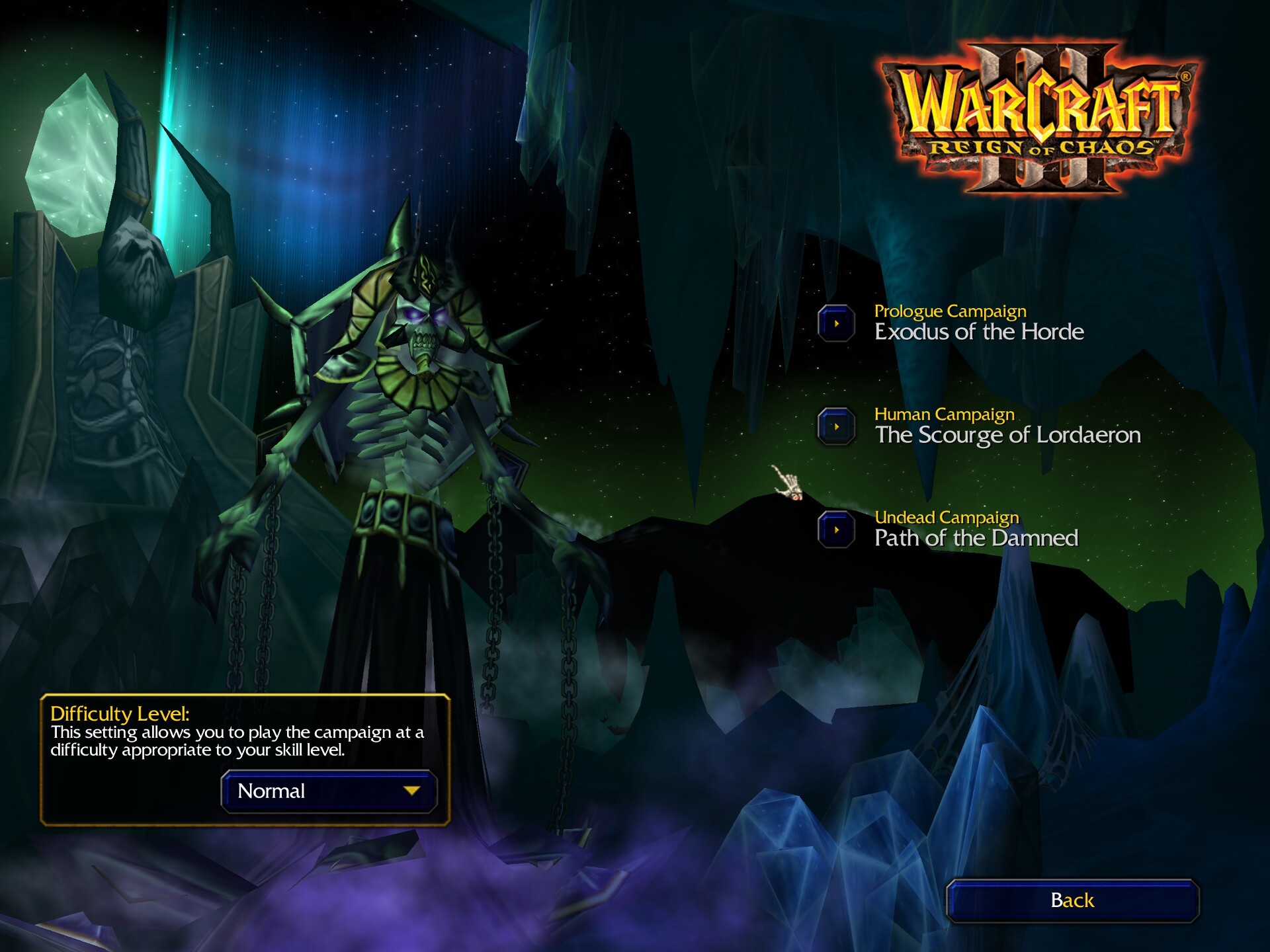
Last time, we stopped at the shocking twist of an undead-looking Arthas returning to Lordaeron and killing his father, cementing his fall to darkness. And please hear me out: this might be an unpopular opinion, but while the human campaign was a compelling story, I don’t think its epilogue, specifically, was executed that well.
Sure, by the end of the campaign, Arthas fell to extreme “ends justify the means” thinking, but he still committed all these atrocities in the name of saving the people of Lordaeron from the Scourge — because he thought he was the only one willing to what it took. Everyone, and everything, was expendable in the name of victory over the undead, and sickness was to be purged. He was a Scarlet Crusader before there was a Scarlet Crusade. A well-intentioned extremist. He was Redcloak, having gone too far to save his people to stop now.
At the end of the campaign, he was not Darth Vader.
Actually, speaking of Darth Vader, there’s a similar problem with his story in the prequels.1 In fact, it’s a problem that often arises in pop fantasy, which a friend of mine likes to call…
Flipping the Alignment Switch
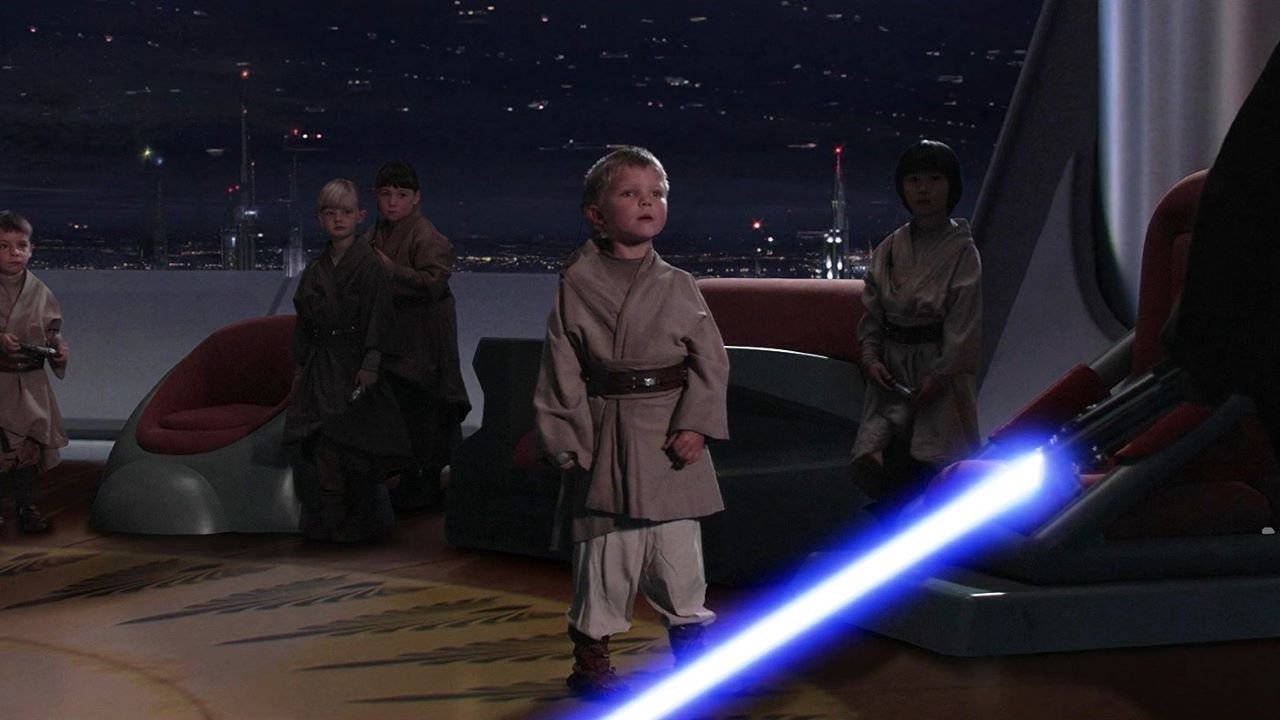
In the original trilogy, once it was revealed that Darth Vader was Luke’s father, it utterly clashed with the image of the paragon Jedi that Obi-Wan painted. The viewers had every right to assume that the elder Skywalker’s fall was tragic, perhaps exploiting some flaws in his otherwise noble psyche, and it gave Yoda’s warnings of the Dark Side so much more weight. If Obi-Wan’s best friend became a tyrant choking his officers for every perceived slight, then anyone could fall to the Dark Side — including Luke himself.
And then, much later, Revenge of the Sith came out. It promised to answer a long-standing mystery: why did Anakin Skywalker turn evil?
…Ummm…
I don’t think that movie gives an adequate answer. Sure, Anakin was a loose cannon with plenty of grievances against the Jedi Order, but it’s a big jump from “Mace Windu tried to kill this self-admitted Sith Lord on the spot instead of giving him a trial” to “Let’s kill all the Jedi, including the younglings”. Revenge of the Sith makes it look like the moment you embrace the Dark Side and are given a Sith name, you instantly turn into an evil caricature of yourself with no moral inhibitions. It’s not that pre-fall Anakin is a particularly nice person, but the moment he becomes Darth Vader, it’s like he becomes a different person entirely. Palpatine flipped his alignment switch.
We see this pattern continue in Knights of the Old Republic. Now, I love that game. It well deserves its universal acclaim. Its storytelling is very impressive… for a 2003 game. By modern standards, it hasn’t aged that well, and a lot of its plot hinges on, if anything, an even more simplistic handling of the Dark Side than in Revenge of the Sith. You redeem a fallen Jedi by flipping her alignment switch. The villain kidnaps one of your companions and tortures her until the torture flips her alignment switch. Then you beat her in battle, which, if you choose Light Side dialogue options, flips her alignment switch back.2 The game handles “falling to the Dark Side” as something binary, and “redemption” as something that means you’re back as your good self and all the evil stuff you did doesn’t count.
This, of course, ignores the very real and tragic reasons that drive people in real life to commit atrocities.
Arthas’s transformation from the well-intentioned sociopath at the end of the human campaign to the completely amoral monster in the undead campaign has a significant gap in it. A gap that is — unlike everything else in the campaign — not shown, but told to us in six short lines of text.
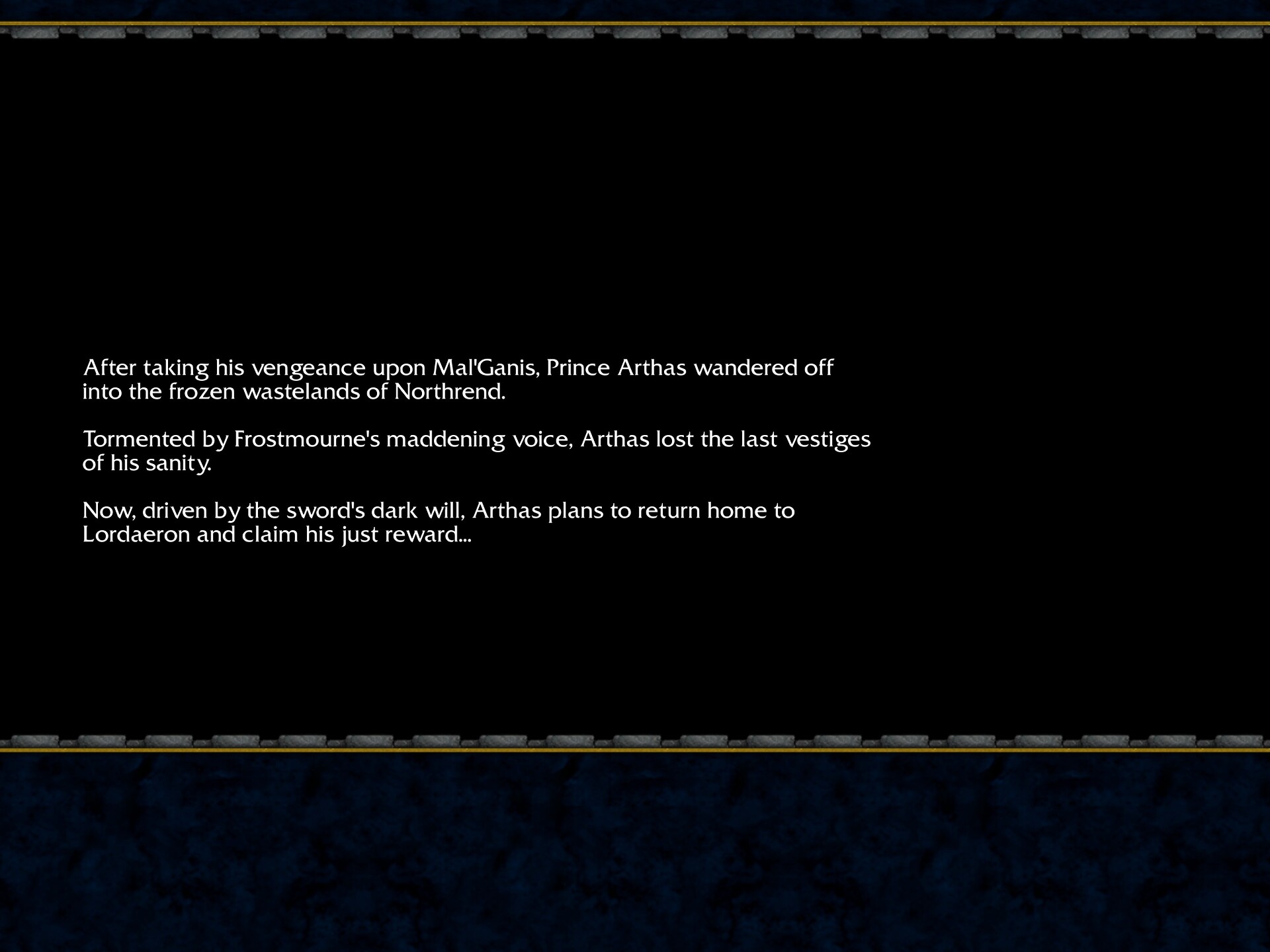
And I’m sorry, but to me, it really doesn’t cut it.
Trudging Through the Ashes
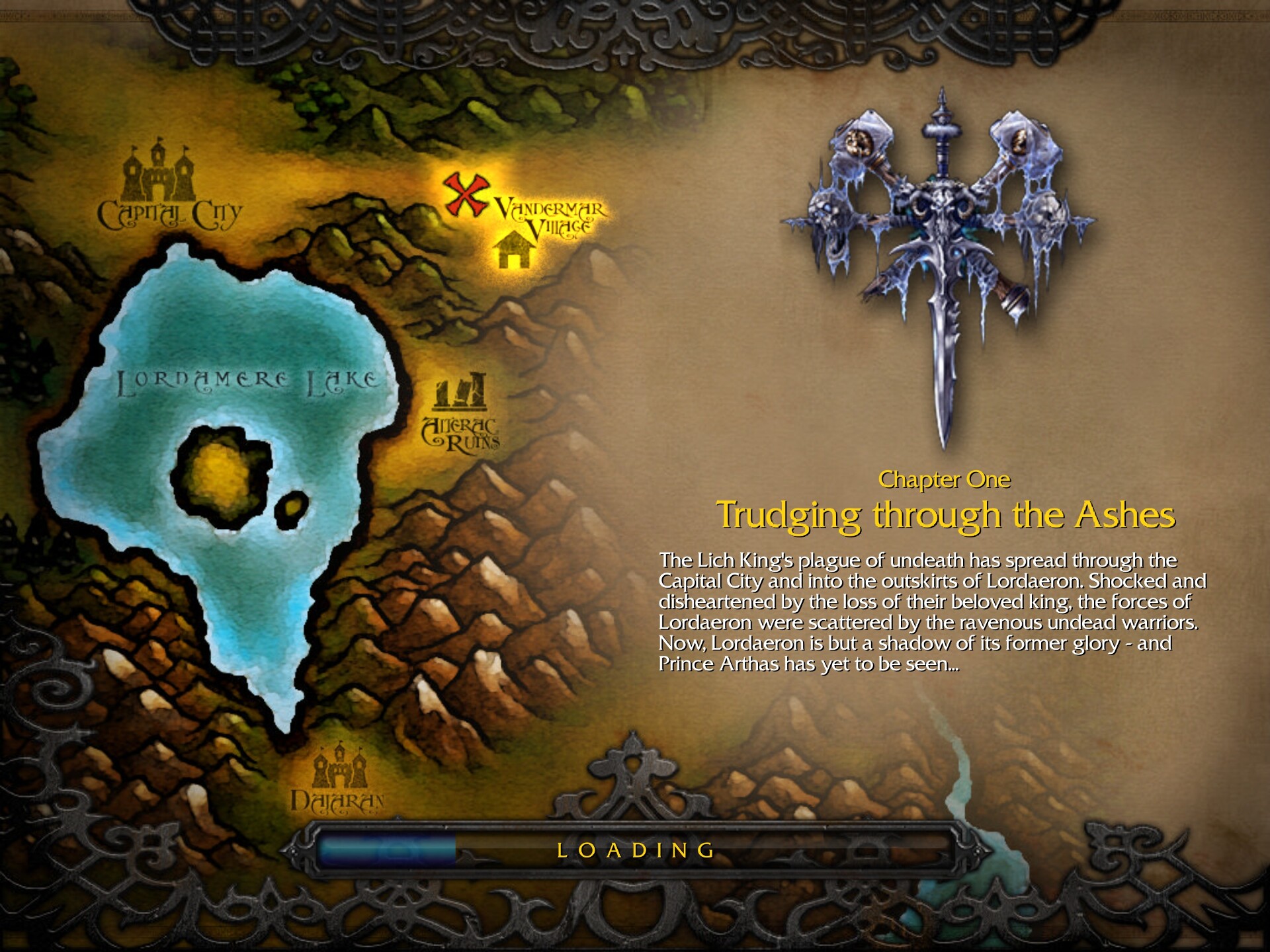
The jarring disconnect between the two campaigns begins with the very first cutscene.
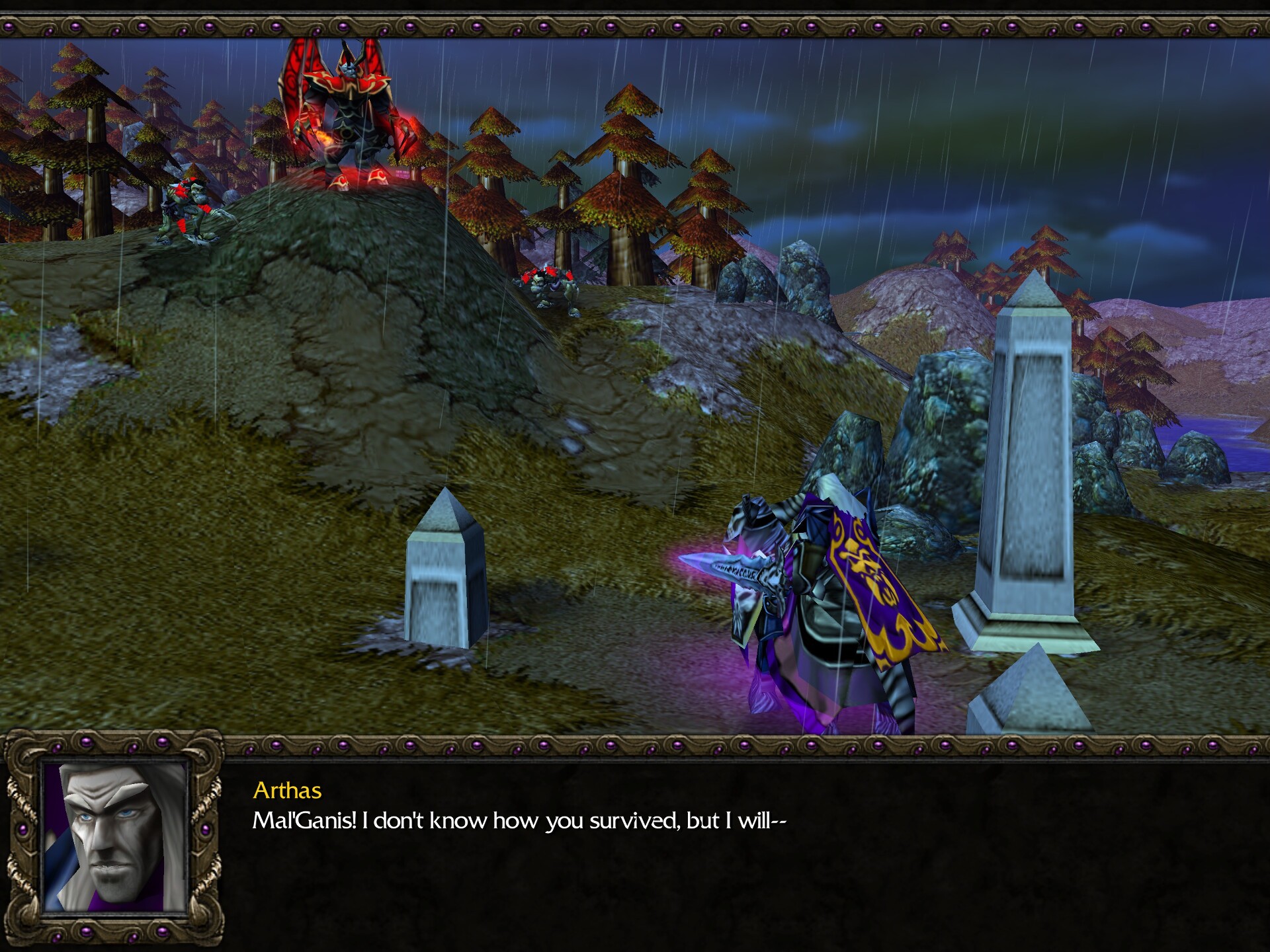
Arthas is teleported to a spot between three obelisks with some kind of green glow. He didn’t seem to expect this, and is disoriented. He now rides an undead horse that he got… somewhere. The two guys who accompanied him to the throne room are nowhere to be found. None of this is explained.
This new dreadlord introduces himself as Tichondrius, a messenger of the Lich King, and he says that by killing his father, Arthas has passed his first test. He explains that the reason Arthas feels no remorse or pity is because Frostmourne, which was forged by the Lich King himself3, claimed Arthas’s soul.
“No! I must kill the undead” he shouted
The sword said “No, Arthas. You are the undead”
And then Arthas was a death knight.
Which… I suppose explains why Arthas has lost all his remaining moral inhibitions, but it doesn’t explain why his goals changed. Why has he suddenly turned from trying to stop the Scourge to working for them? Does he have a choice in this matter? Is he under a mental compulsion, a slave of the Lich King, or has Frostmourne basically rewired him to the point that he’s not Arthas anymore, but just some… thing puppeting his body and using his memories? What are his own goals? What does he himself want now, as opposed to what Tichondrius and the Lich King want him to do?
The game isn’t interested in exploring these questions. It presents Arthas’s personality overwrite as a given and acts as if all he cares about now is doing whatever the Lich King asks of him. The end result is that undead Arthas feels like a completely different person who just happens to have human Arthas’s memories.4
But something still isn’t right. In the human campaign, the Lich King5 had a direct line to Arthas through Frostmourne, giving him a surprise order to kill Mal’Ganis. Here, the Lich King never contacts Arthas directly, and instead all the orders come from Tichondrius. It doesn’t seem like anything happened to the sword in the interim, so it’s weird that the game sets up the plot element of “the Lich King can covertly contact Arthas behind the dreadlords’ backs” and then never uses it again.
The first task Tichondrius gives is reassembling the Cult of the Damned, which went into hiding after Arthas dealt it a blow at Andorhal. This doesn’t sound like that big a deal, really. The acolytes are blending in among the peasantry, so all Arthas needs to do is find one acolyte outside town and ask them to visit the other acolytes in hiding and tell them to meet at some secret gathering place. Simple, efficient, and doesn’t draw attention.
…No, of course instead he’s going to charge into town with two very conspicuous ghouls. Sigh.
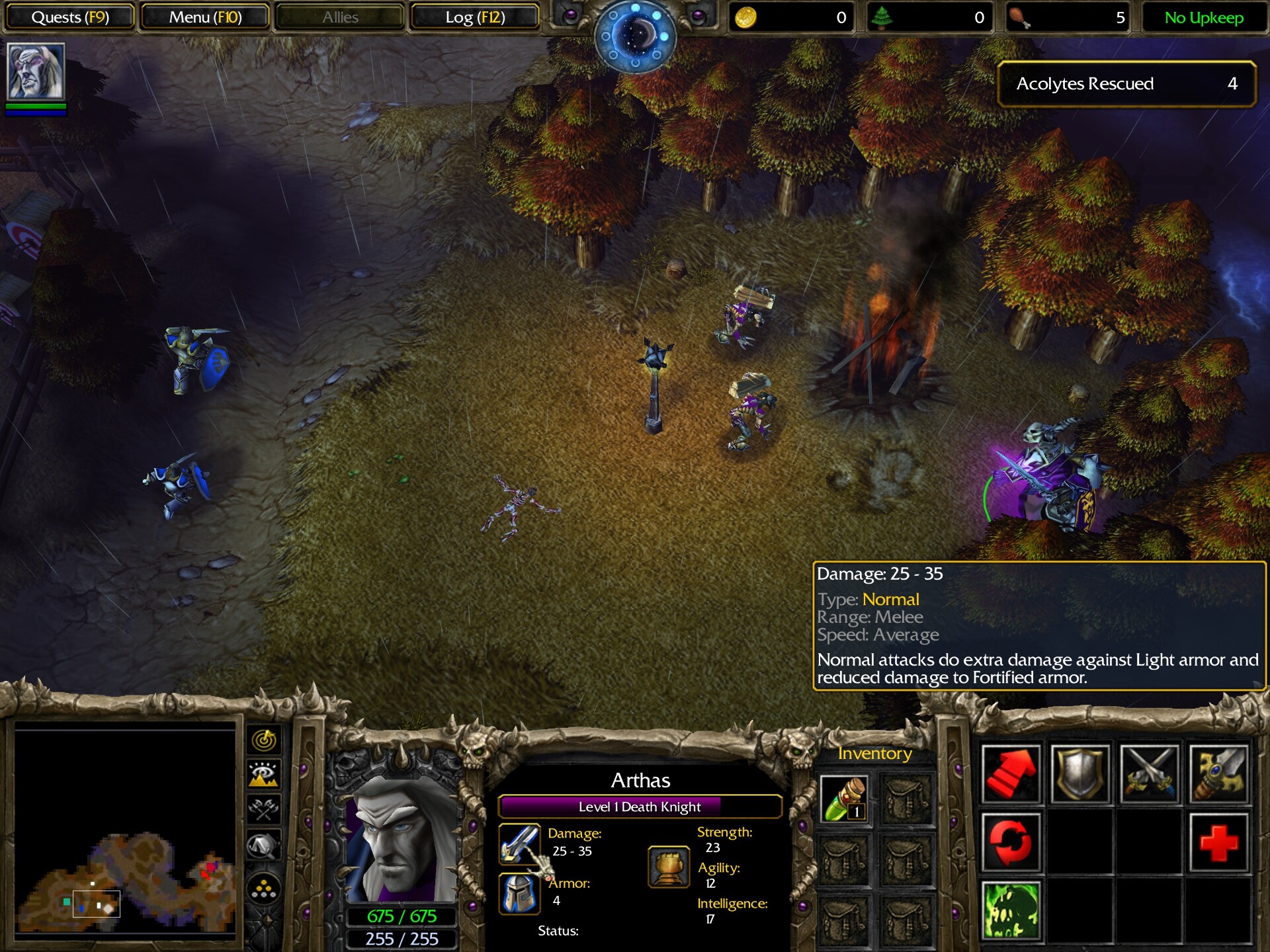
Our forces are paltry. Arthas, who was a level 10 powerhouse uber-paladin, is now a level 1 death knight. While you could justify this by saying he’s weakened because the Light abandoned him, losing his entire inventory really makes no sense story-wise, nor does the fact that he now does Normal damage, when Chaos damage was one of the big selling points of picking up Frostmourne in the first place. Last I checked, it’s still the same sword. Warcraft 3 is usually good at integrating gameplay with story, which makes the few times it doesn’t do that all the more jarring.
We have to search the town for acolytes in hiding, who look like peasants tinted red. Once found, they reveal their true allegiance as acolytes and teleport away. The town is patrolled by footmen, captains, and eventually knights, and your forces consist of a squishy level 1 hero and two really squishy ghouls, so you can’t really afford to face the guards in open combat — at least, more than a single unit at a time — and instead are supposed to evade them.
Luckily, Arthas starts with the Death Coil ability, which is the exact opposite of his old starting ability. The paladin’s Holy Light heals living allies and hurts undead, and Death Coil… well…
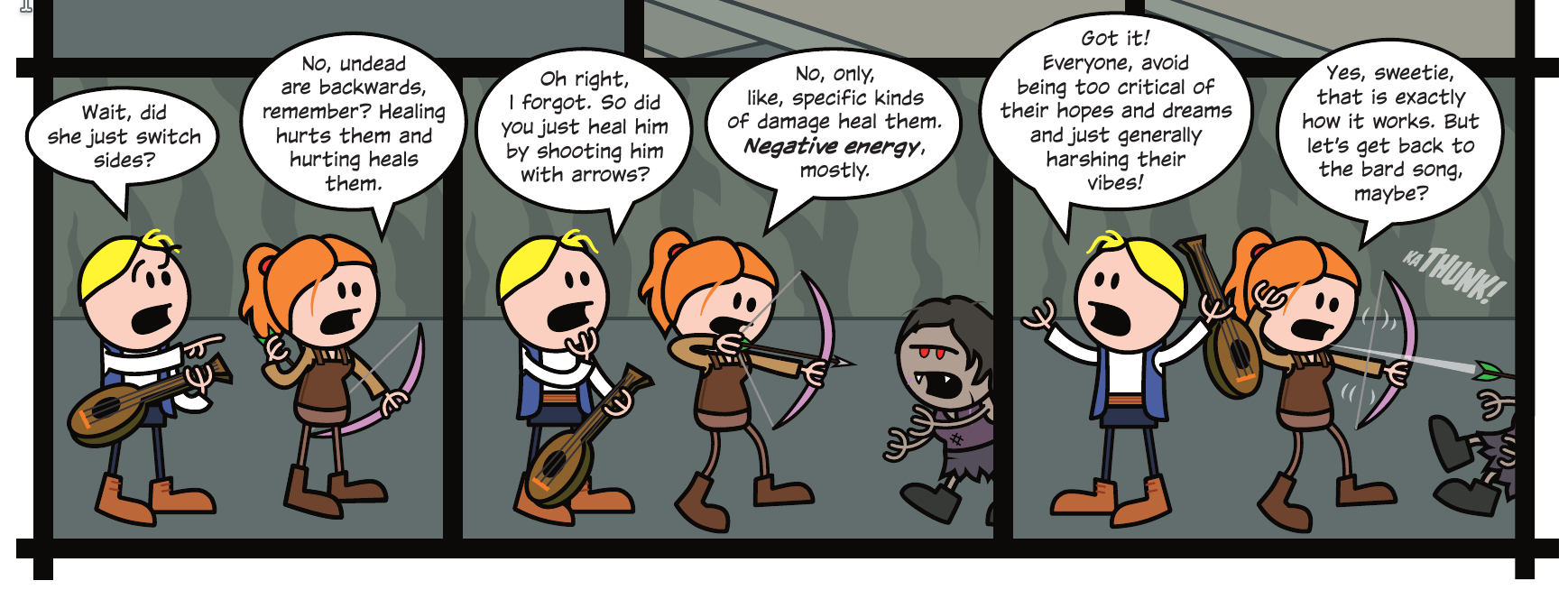
Death Coil can be used both to heal your own ghouls, and to kill fleeing villagers before they alert the guards.
The actual mission is kind of a slog. It’s mostly a stealth mission, and you’re given a shade (an invisible scout unit) to look ahead for acolytes in hiding before you approach them with Arthas, and there are twenty of them scattered across town. There are some Easter eggs, like two fistfighting villagers named Robert and Tyler, and places to explore like the bandit camp in the northwest. There are actually more acolytes around than you need to rescue, practically guaranteeing that you’ll miss some secrets on your first playthrough.

Once the acolytes are rallied, Tichondrius moves to the next stage of the plan, which is…
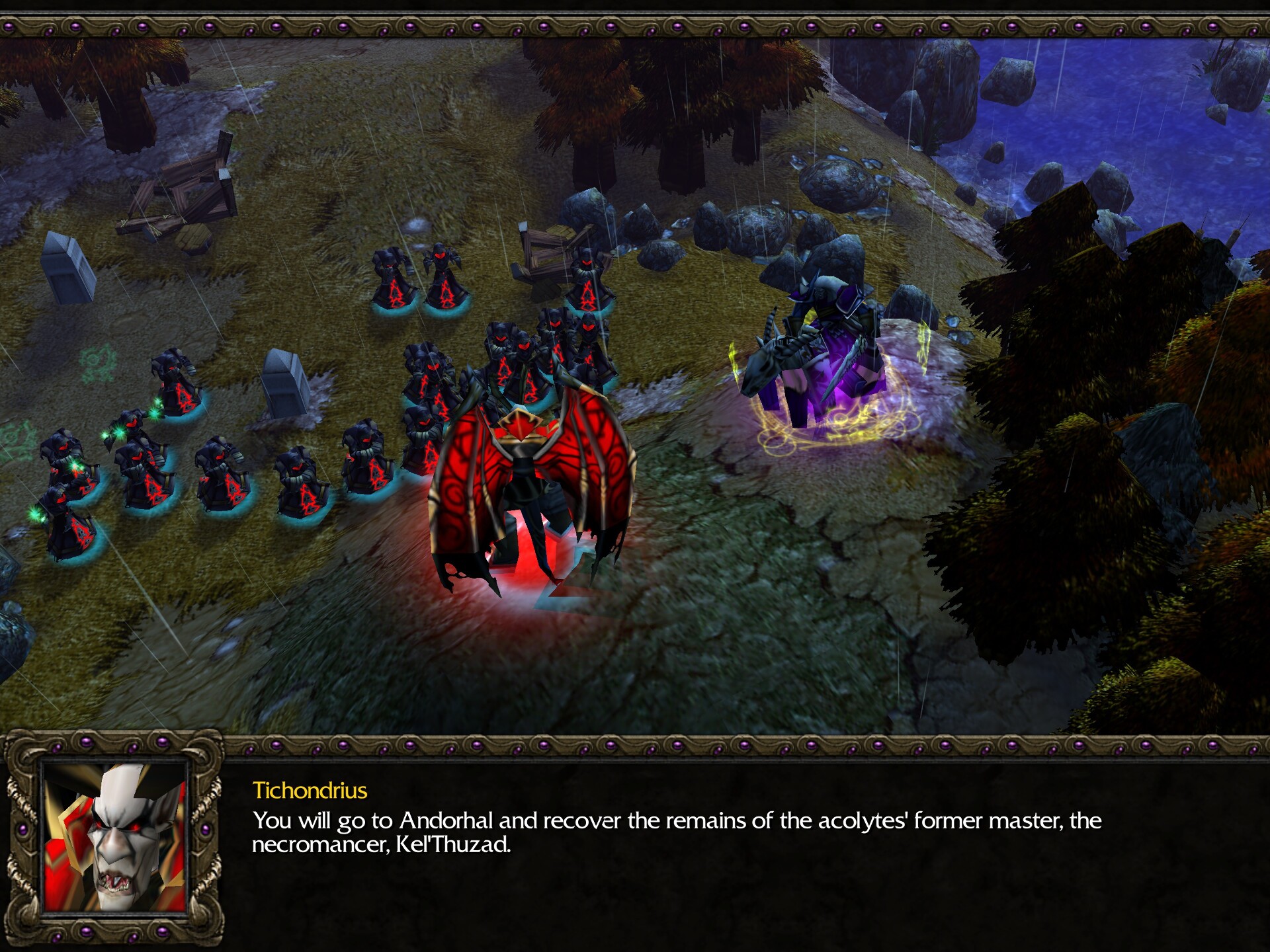
Wow. All of Arthas’s progress against the Scourge in the human campaign is being undone, fast.
Digging Up the Dead

We’re continuing the pattern where the first mission introduces a hero class and the faction’s basic fighting unit, and the second one runs the player through the basics of base building here. First of all, the acolytes present Arthas these contraptions for transporting Kel’Thuzad’s remains, to which he has a very understandable reaction:
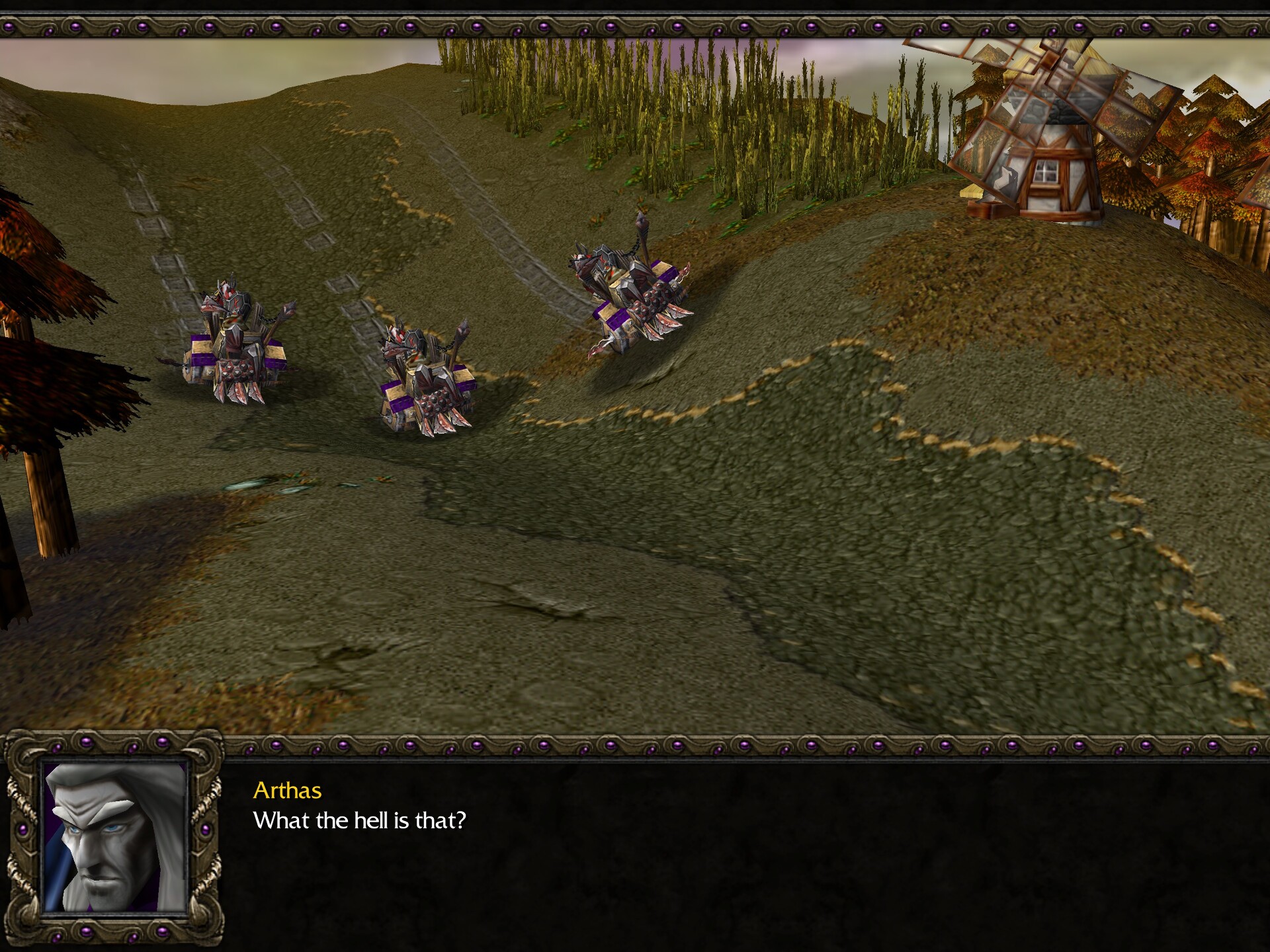
These are meat wagons — the siege unit of the undead faction. They can also transport corpses, which for now has little use except for letting your ghouls cannibalize them.
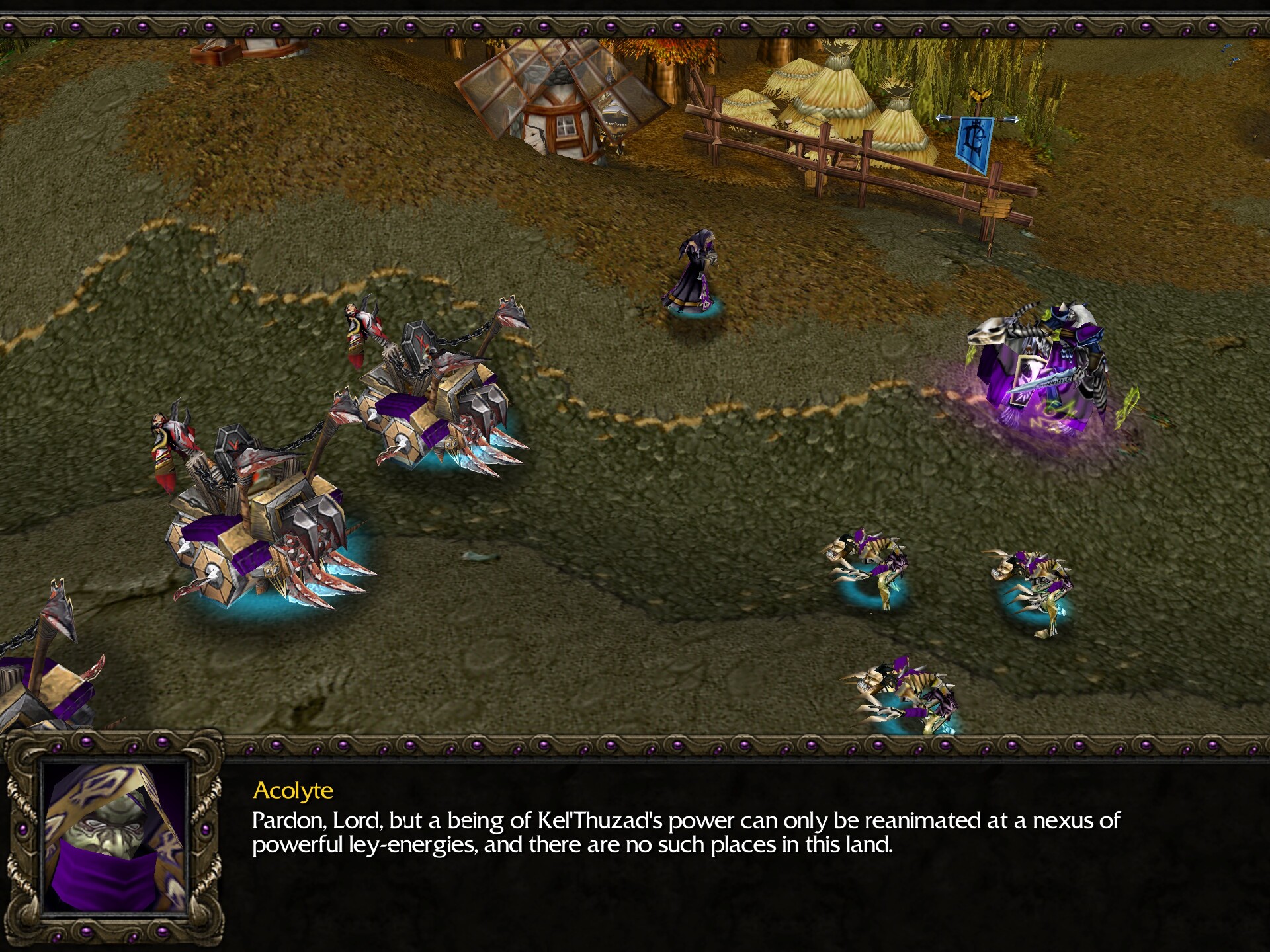
This presents a bit of a hassle, though. The first part of the mission, taking place at the very top of the map, involves getting to Kel’Thuzad’s tomb (wait, they actually buried him in a fancy tomb?), and you have Arthas, ghouls, and meat wagons. Unfortunately, ghouls are really squishy and take damage from your own meat wagons if you just auto-attack everything in sight. It’s better to micromanage, attacking units with Arthas and the ghouls and using the meat wagons on buildings only.
Kel’Thuzad’s tomb is defended by a paladin who tries in vain to appeal to Arthas’s conscience. Near the tomb itself, Arthas is greeted by…
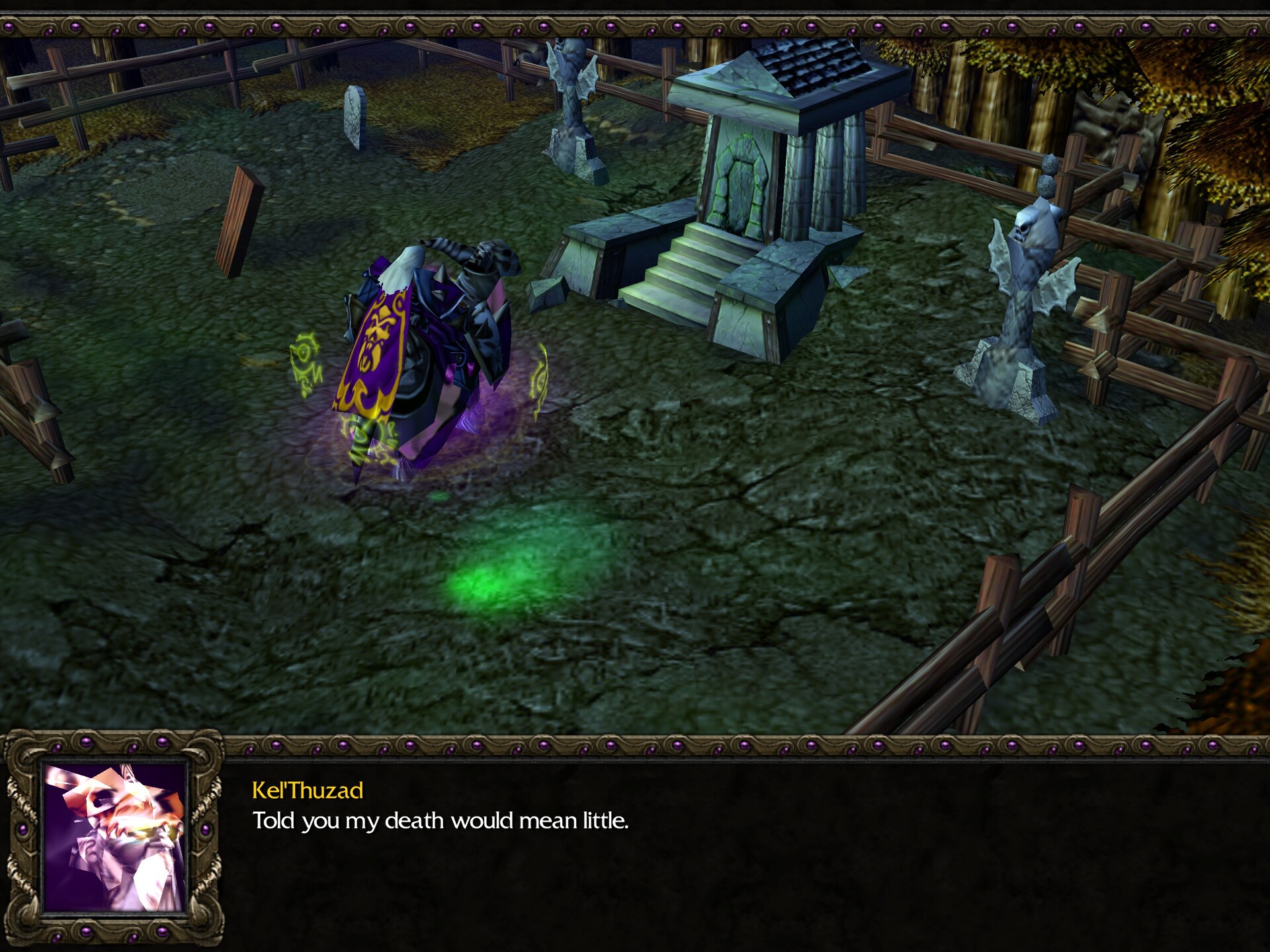
…Kel’Thuzad’s ghost?
Tichondrius isn’t happy. The remains are badly decomposed and won’t survive the journey to Quel’Thalas, where he plans to raise Kel’Thuzad — because the high elves’ Sunwell has just the right kind of magical mojo for that. But to preserve the remains, Arthas needs to put them in a special urn that’s guarded by the local paladins.

The objectives update, instructing you to build a base. Building an undead base from scratch is a bit annoying because, like the zerg in Starcraft, new buildings can only be placed on special ground created around existing buildings. So I have to wait for my initial buildings, the necropolis and the haunted gold mine, to be ready before I build anything else. While waiting, I explore the southeast with whatever units I have, snagging a nice Pendant of Energy from a level 9 Granite Golem.
(Annoyingly, these early undead missions are kind of stingy on loot. They do have good items, but most of them are found in secret areas that I missed in my playthrough.)
Besides the zerg, the undead faction steals a page from the protoss. Like the protoss probe, their worker unit, the acolyte, only starts the process of “summoning” a building, which continues by itself while the acolyte can go back to whatever he was doing (which is usually gathering gold). Also, acolytes don’t gather lumber; ghouls do that.
Ghouls are kind of the “zerglings” of the undead faction, in that they’re cheap and quick to build, but individually weak. Spamming ghouls isn’t optimal because they cost the same amount of food as footmen, but are weaker in every way. Unfortunately, in this mission, ghouls and meat wagons are all you have, so I built two crypts, set the rally point to Arthas, and just kept pumping ghouls non-stop to crush all opposition. Undead are the “we have reserves” faction.
There are a couple of secrets in this mission. First, there’s this out-of-the-way spot in a village disconnected from the questing area:
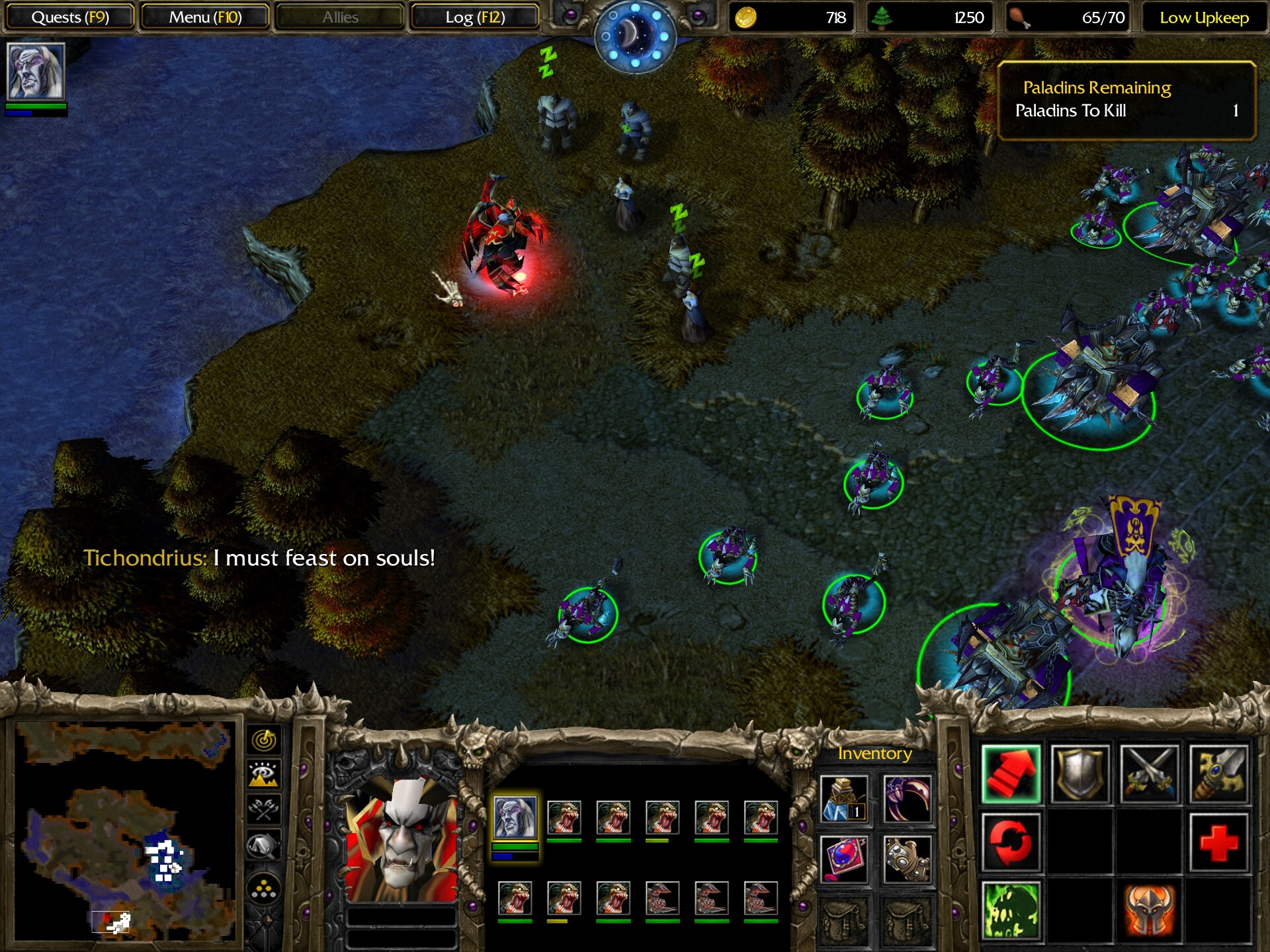
Then he omnomnoms the charmed villagers. Eesh.
Another secret is a waterfall that can be reached by cutting a path through a lot of trees. When approached, you get the message “SECRET FOUND — Pandaren relaxation area”, and get treated to this nice artwork by Samwise Didier:

The three paladins you need to kill are Ballador the Bright, Sage Truthbearer, and, surprise surprise, Uther.
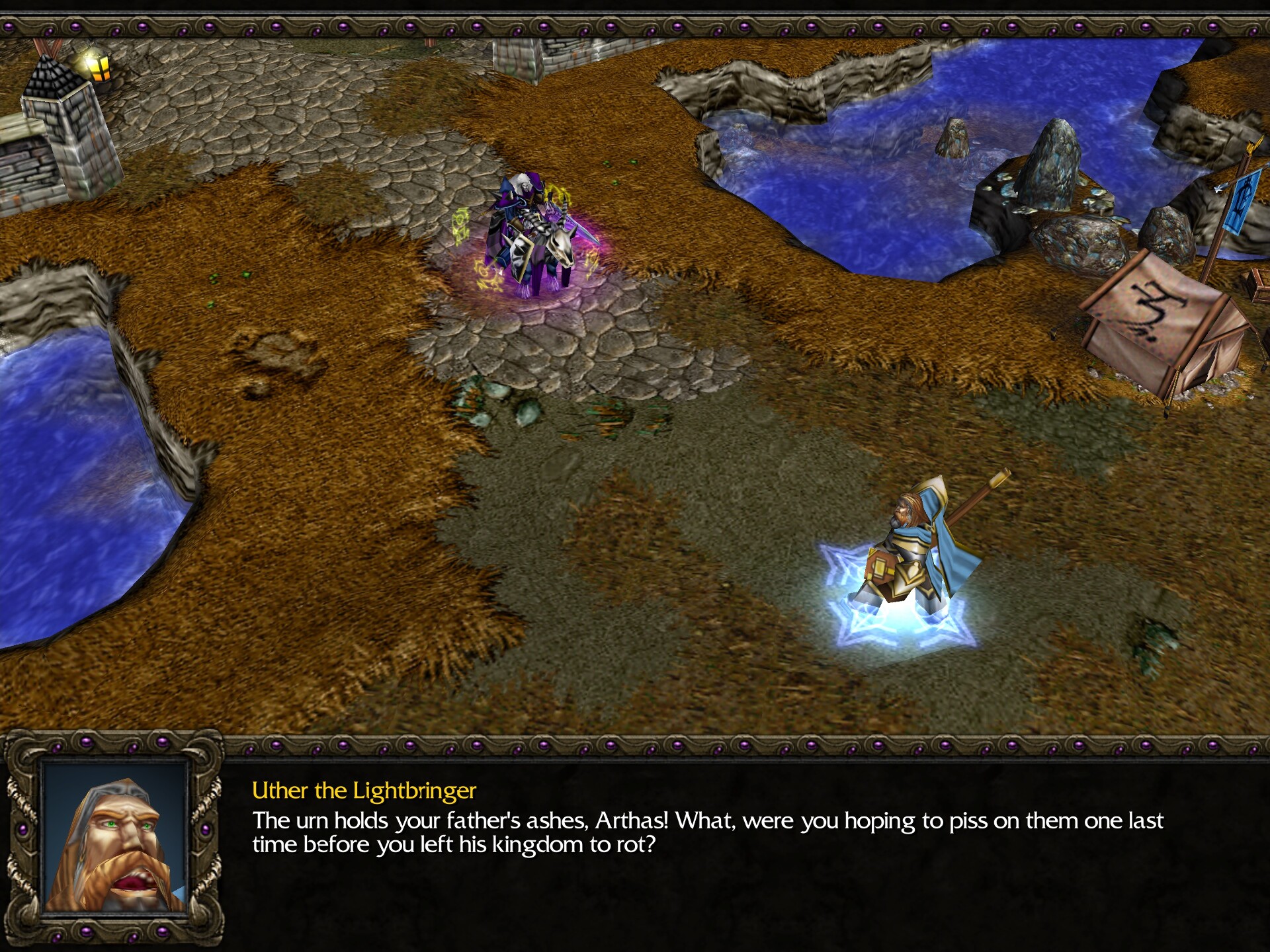
Arthas didn’t even know what the urn contained, nor does it concern him. He’s focused completely on his goals, and any collateral damage is to be brushed aside.
Uther may be a level 10 powerhouse, but he’s still one hero. Eventually, he falls.
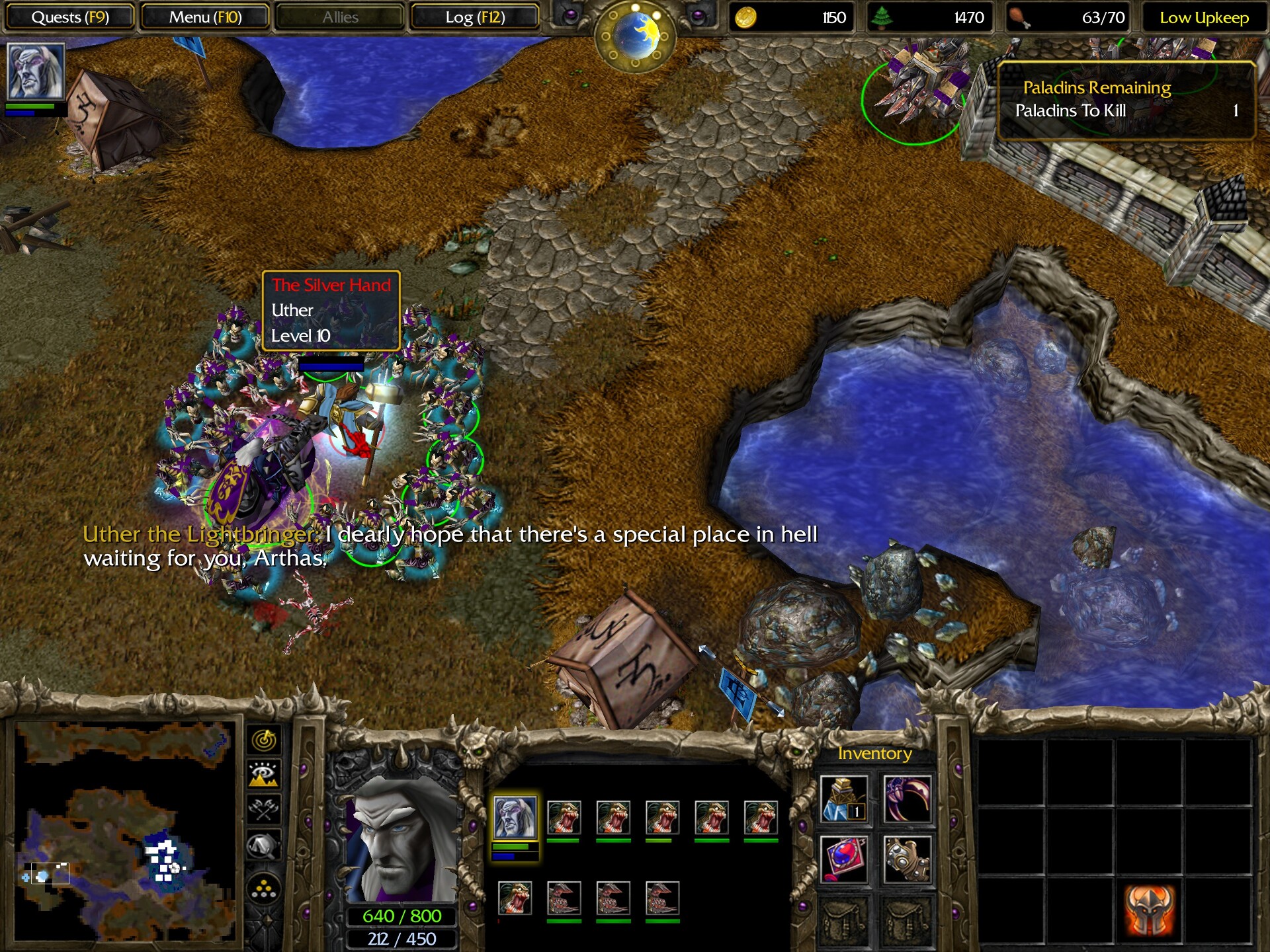
In a nice moment of developer foresight, killing Uther doesn’t actually end the mission — only picking the urn does. This gives you the chance to explore the southwestern corner and pick up a Scroll of Protection.
Arthas puts Kel’Thuzad’s remains in the urn and is ready to travel to Quel’Thalas, but there’s a new twist thrown in.
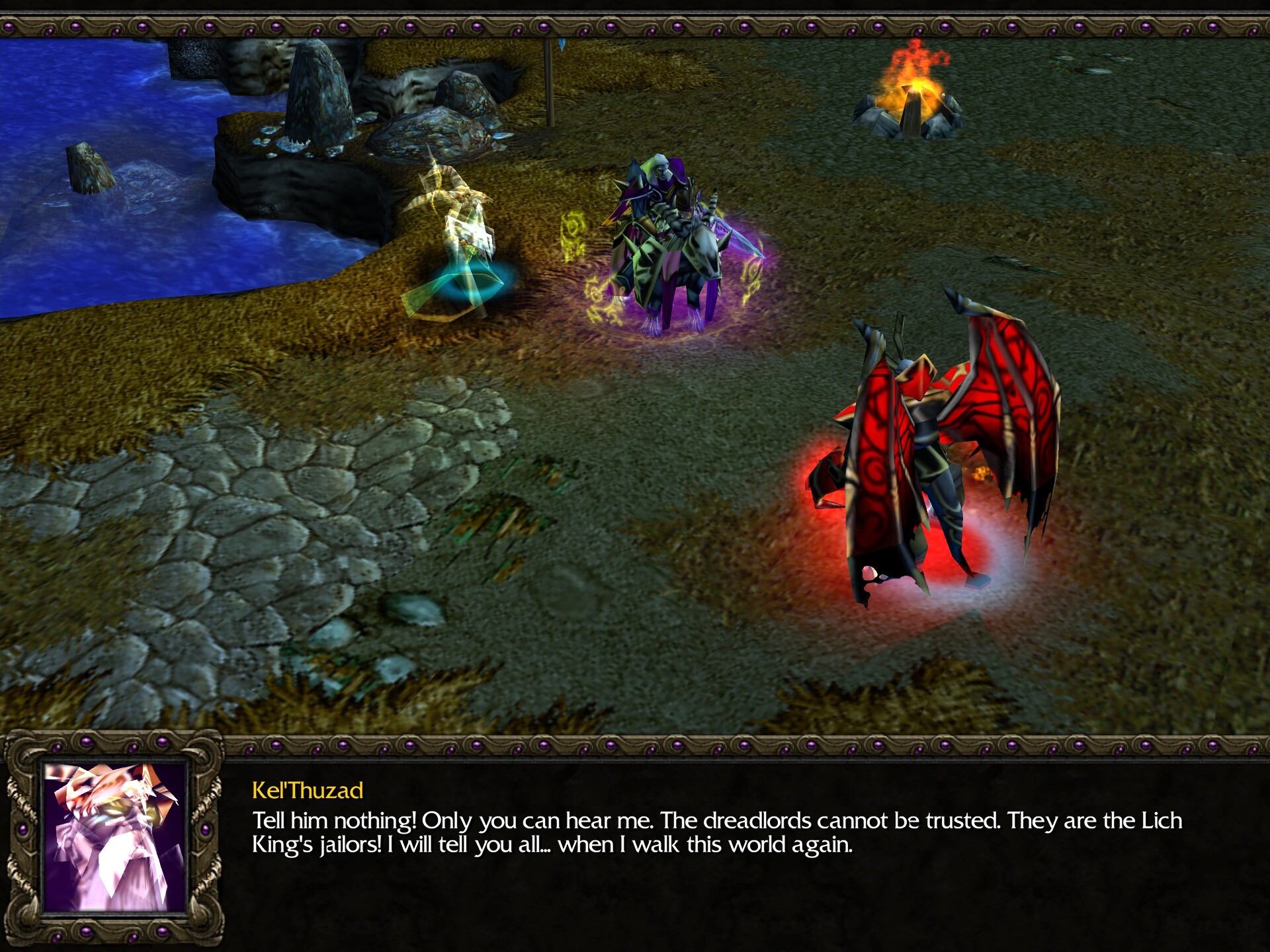
So the human campaign established that Arthas had a direct line to the Lich King that the dreadlords couldn’t hear. Now that bit of setup is forgotten, but Arthas has the company of the ghost of a trusted servant of the Lich King… whom the dreadlords can’t hear. It still works, and I realize why they did it this way, but it’s still kind of weird.
While Arthas is preparing to bulldoze his way through the elven lands…
The Dreadlords Convene
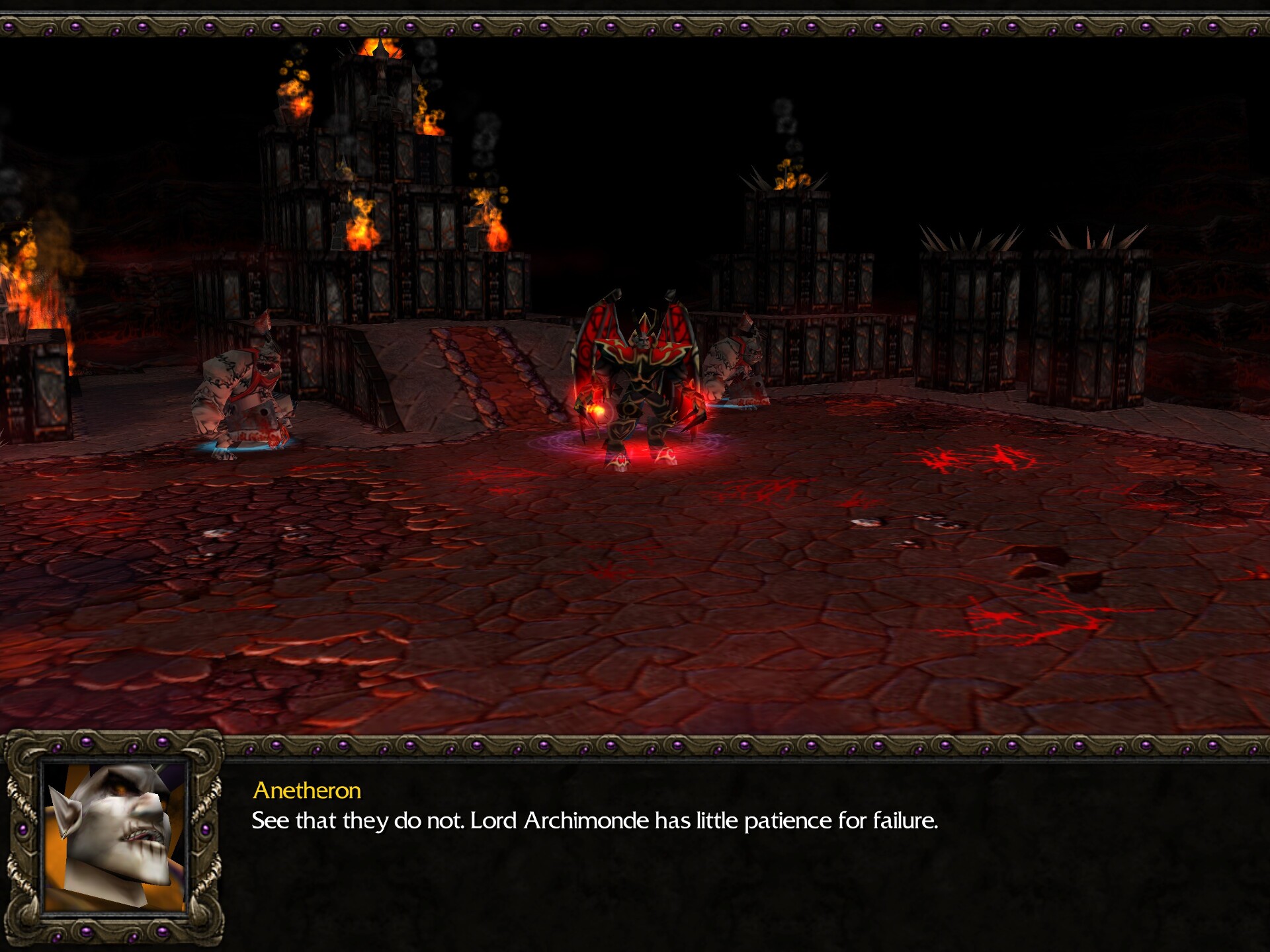
In the Twisting Nether, Tichondrius rendezvoes… rendezvouses? Meets fellow dreadlords Anetheron and Mephistroth, who express their concerns about the Lich King’s possible ulterior motives about Arthas in plain hearing of some Scourge acolytes. This short interlude establishes, for people who haven’t read the manual, that the Lich King is Ner’zhul, the Scourge is a tool of the Burning Legion, and the dreadlords answer to Archimonde, who is preparing for the Legion’s return. The Legion and the Scourge are, emphatically, not friends; Ner’zhul was forced into servitude, and we’re getting more and more evidence that he has plans of his own — plans that don’t align with the Legion’s best interests.
Foreshadowing!
Into the Realm Eternal
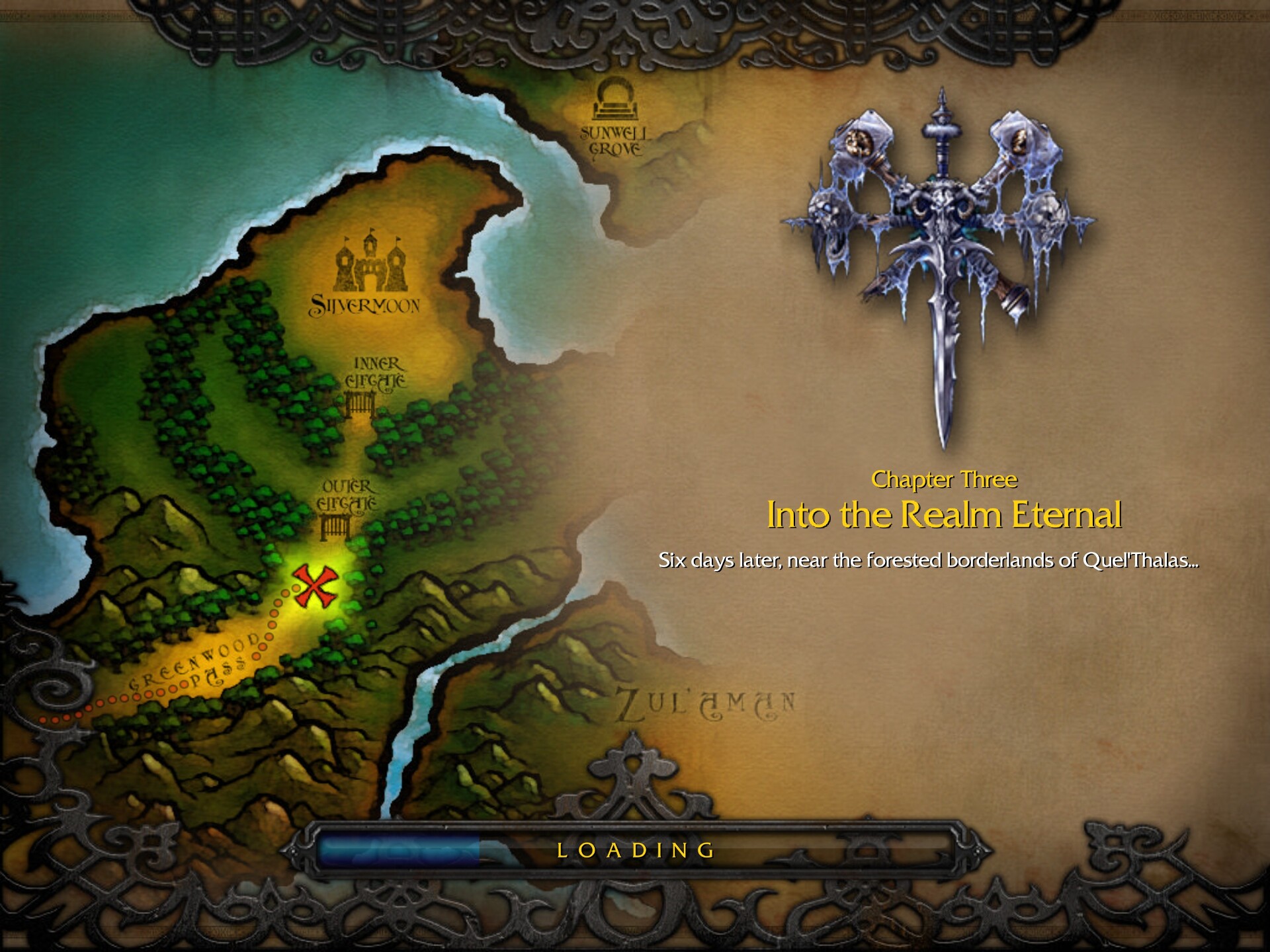
Arthas and his army reach the borders of Quel’Thalas, which we see for the first time in the Warcraft franchise. It is a beautiful enchanted elven realm that looks like… Lordaeron, apparently.
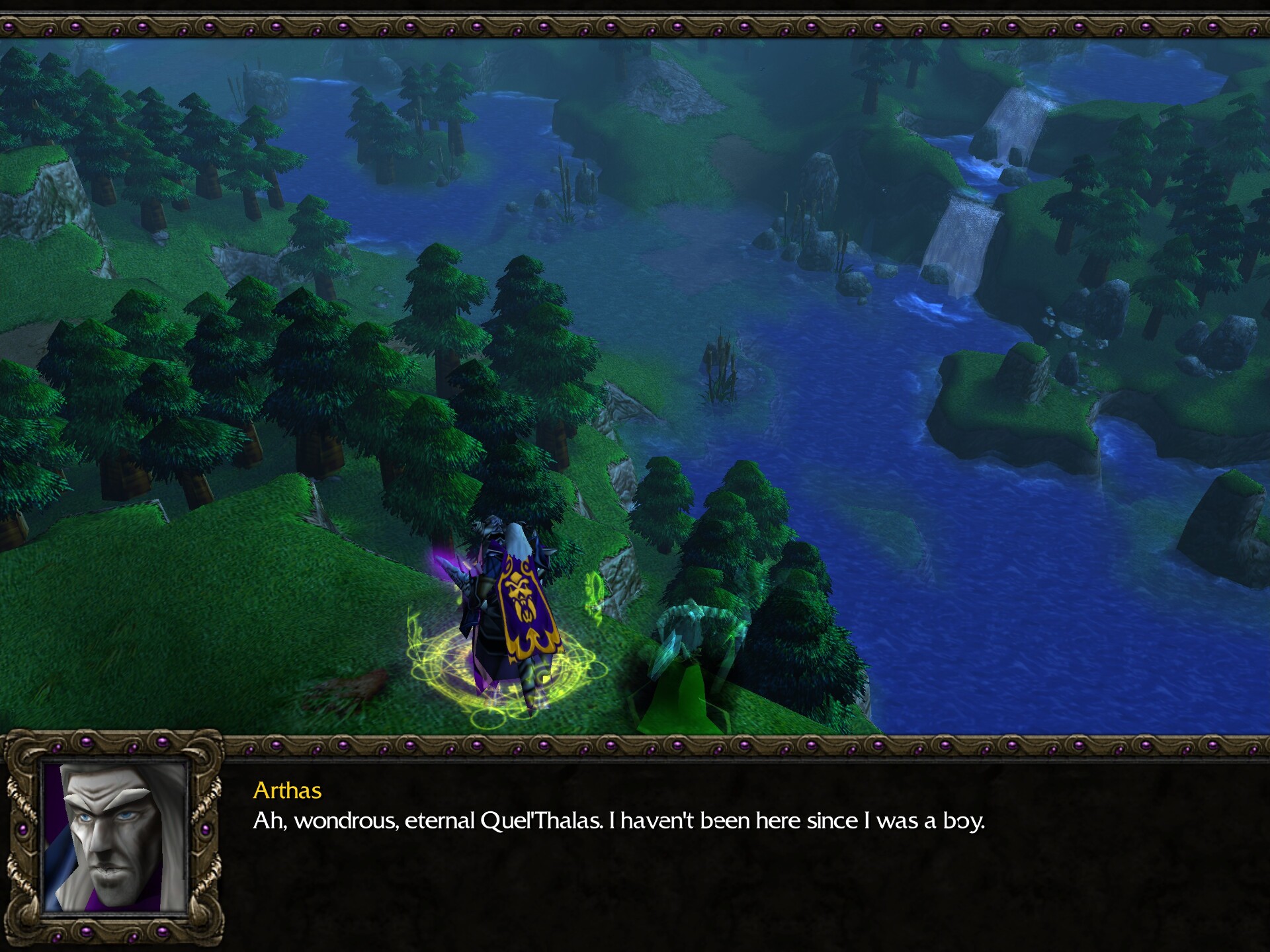
The Scourge captures an elven priest, and Arthas interrogates him on how to enter the land. The priest, who weirdly looks like the Emissary from the human campaign rather than an actual priest, boasts…

Arthas is, naturally, undeterred by the trees. He brings meat wagons, which cut a way through the trees right towards the first, weakly defended elven base. You transition from the cutscene into gameplay, with your units in the middle of destroying the base. Then, you build yours over it — from scratch.
While the base is still under construction, Arthas get a special guest.
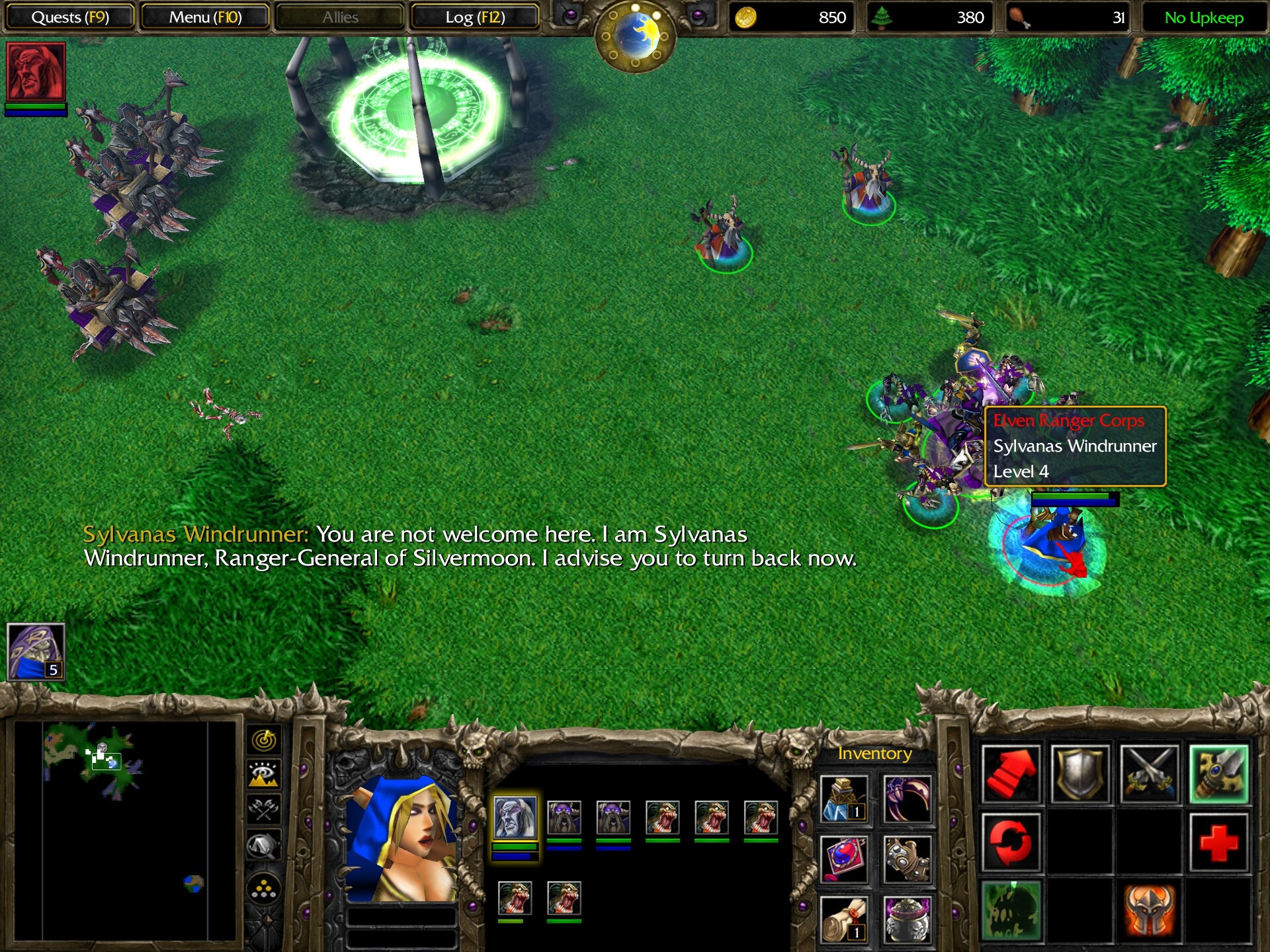
If Sylvanas’s last name looks familiar, it’s because we had a Vereesa Windrunner in Day of the Dragon. We don’t yet know if there’s any relation between them, apart from both being rangers of Quel’Thalas.
She promptly dies, but as a hero in a base-vs-base mission, she’s going to come again, and again, and again. Or at least, she’s supposed to. For some reason, in my playthrough, my base was only attacked by some generic swordsmen and archers after I repelled Sylvanas’s initial attack, and after that, nothing.
Initially, all exits from your base are closed by trees, which you need to destroy to proceed. This also gives the enemy an opening through which to attack you in turn. So I opened only the eastern entrance and then advanced towards the objective — the blue elven base protecting the gate — in an S-like shape.
In this mission, you get necromancers. These guys are awesome. They can raise skeletons from corpses on auto-cast, and they synergize well with meat wagons.6 Meat wagons can pick up corpses (which auto-spawn at your graveyard) and ferry them across the map, then unload them where you need them. A necromancer somehow raises two skeletons from each corpse, which… okay, weird, but fun. Against masses of squishy units like the high elves, this starts a chain reaction, and soon you have a whole horde of skeletons overwhelming the enemy base.

The high elves are kind of a pseudo-faction of their own, if an awkward one. They use a mix of human buildings and unique ones, some high elf units from the Alliance faction (sorceresses and priests), the high elven swordsman (basically a reskinned footman), and their archers are recolored night elf archers (we’ll get to these). Sylvanas’s model is also a recolor of a night elf campaign character model, which might explain why her ears aren’t upright like those of a typical high elf.
The gate falls, and Sylvanas retreats.

Key of the Three Moons
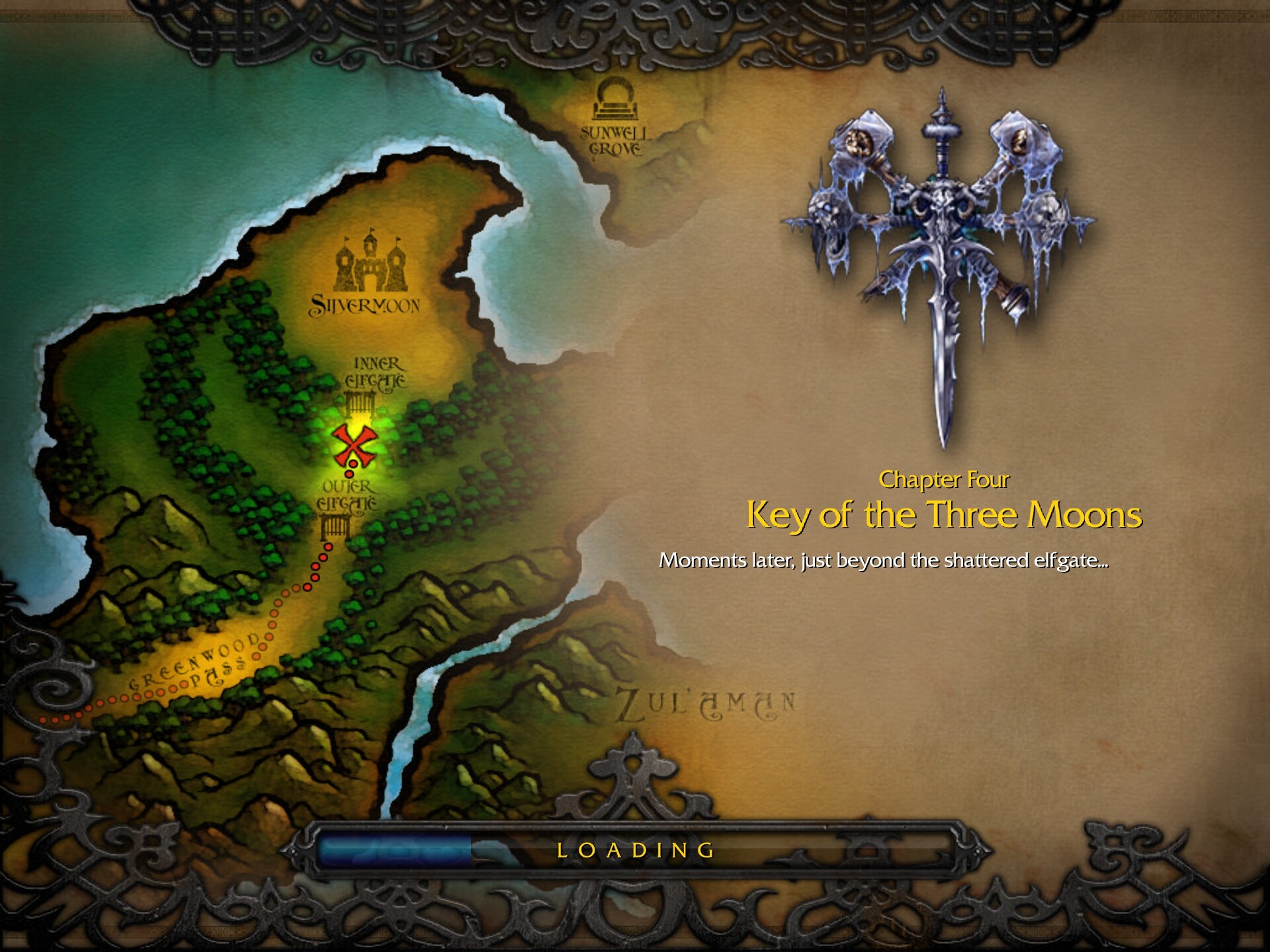
Arthas shatters the gate and pursues Sylvanas. In return, she does this:
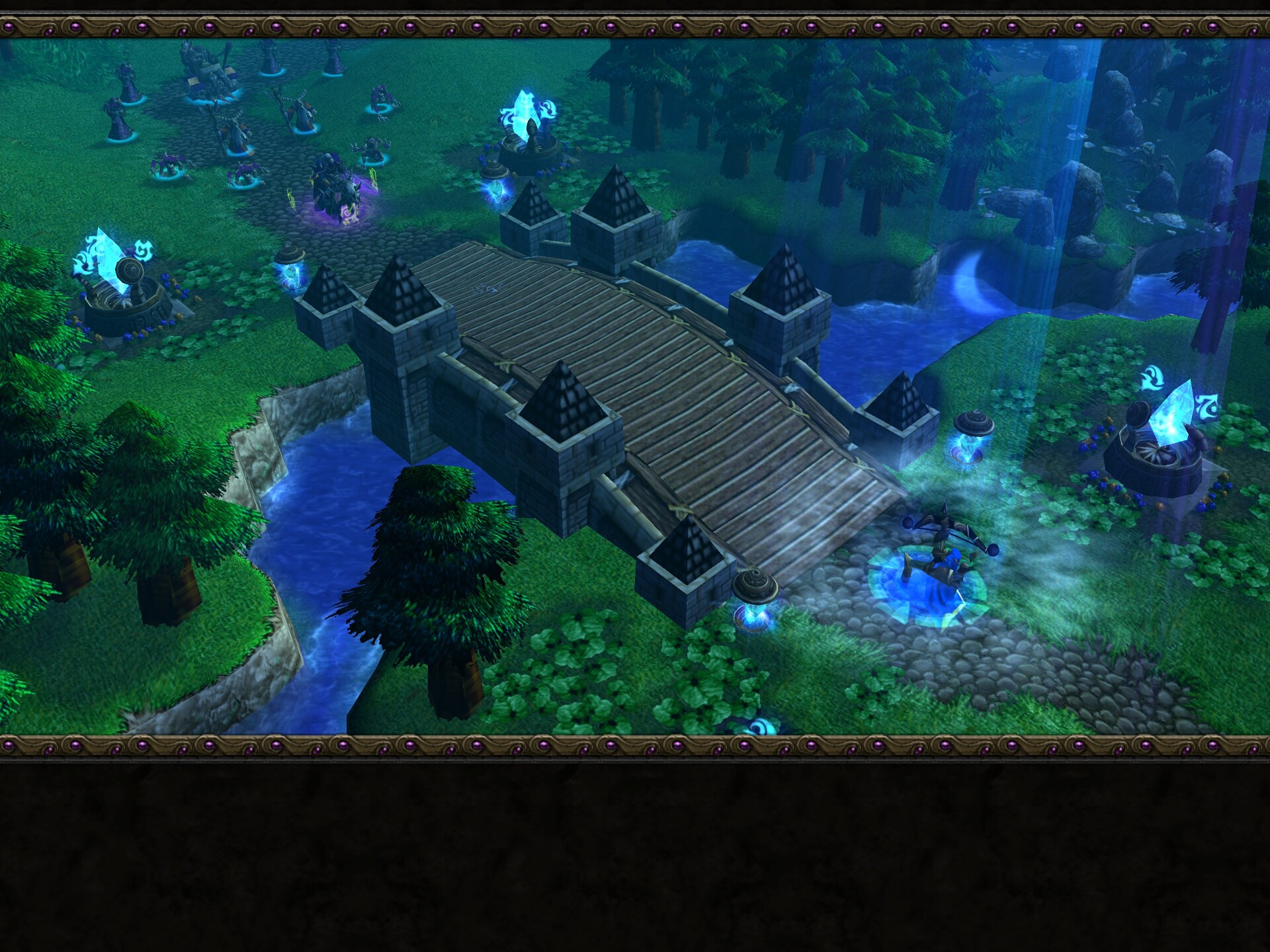
Whatever spell it is, it collapses the bridge. Arthas curses and looks for another way to cross the river.
This is important. This is very important. The narrative very definitely establishes that Arthas has no means of crossing water on his own.
Remember this, because it will be relevant later.
Once again, we attack a small elven outpost and establish our base on its ruins. This time, the elves have flying units — dragonhawk riders — which most of your units cannot attack. However, in this mission you get crypt fiends, undead nerubians from Northrend. Their web ability temporarily grounds flying units, making them vulnerable to melee.
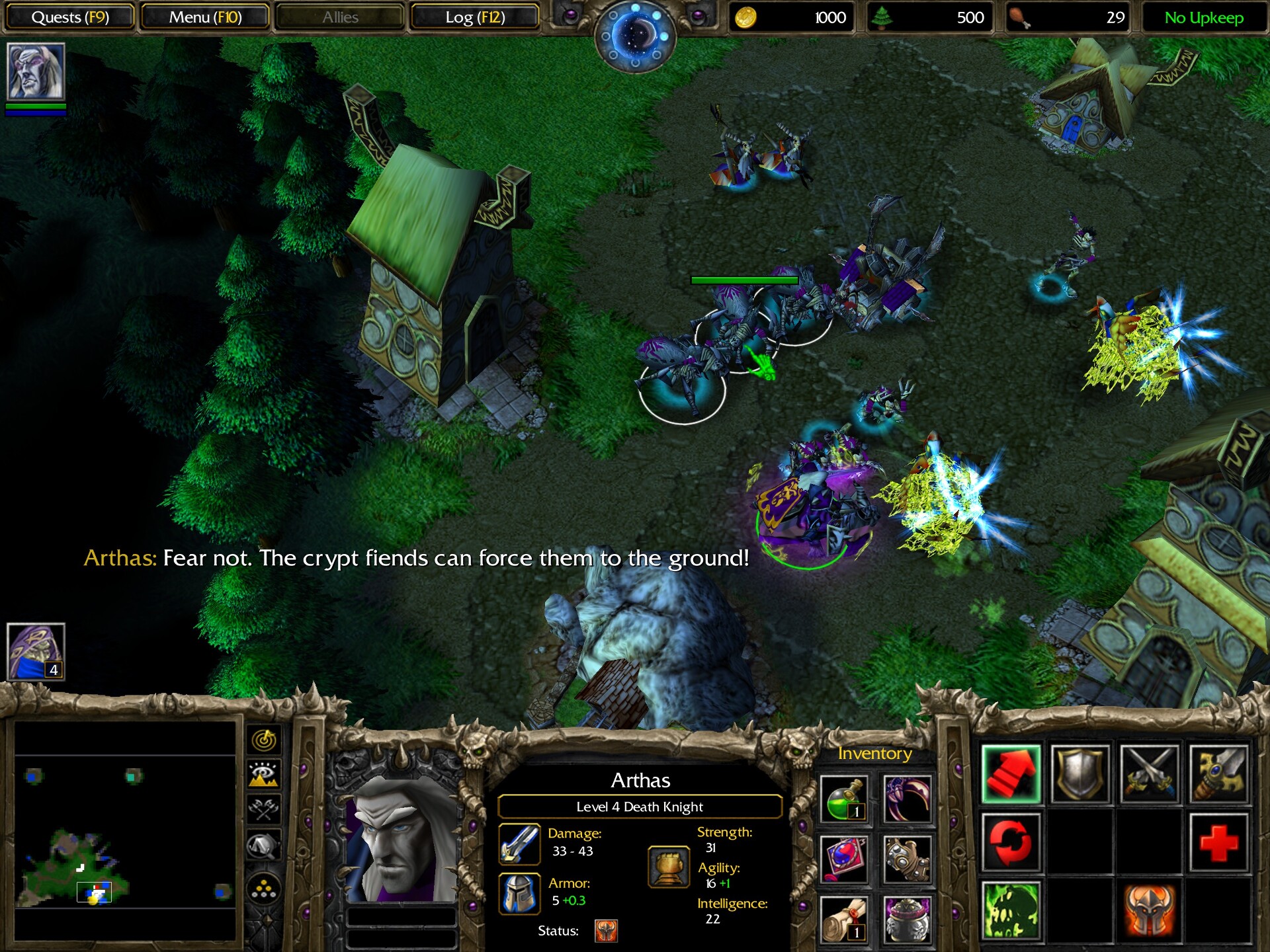
Our objective here is to collect three pieces of a special key that opens the inner elfgate. The catch here is that this map is split into islands, and you need to find a way to cross from one island to the other.
These means shortly present themselves in the form of goblin zeppelins. I board them and take out the eastern elven base with my starting army while my own base is building.
Now here comes the really hilarious part. The game doesn’t tell you this, but you can actually repair the sunken bridge with acolytes!
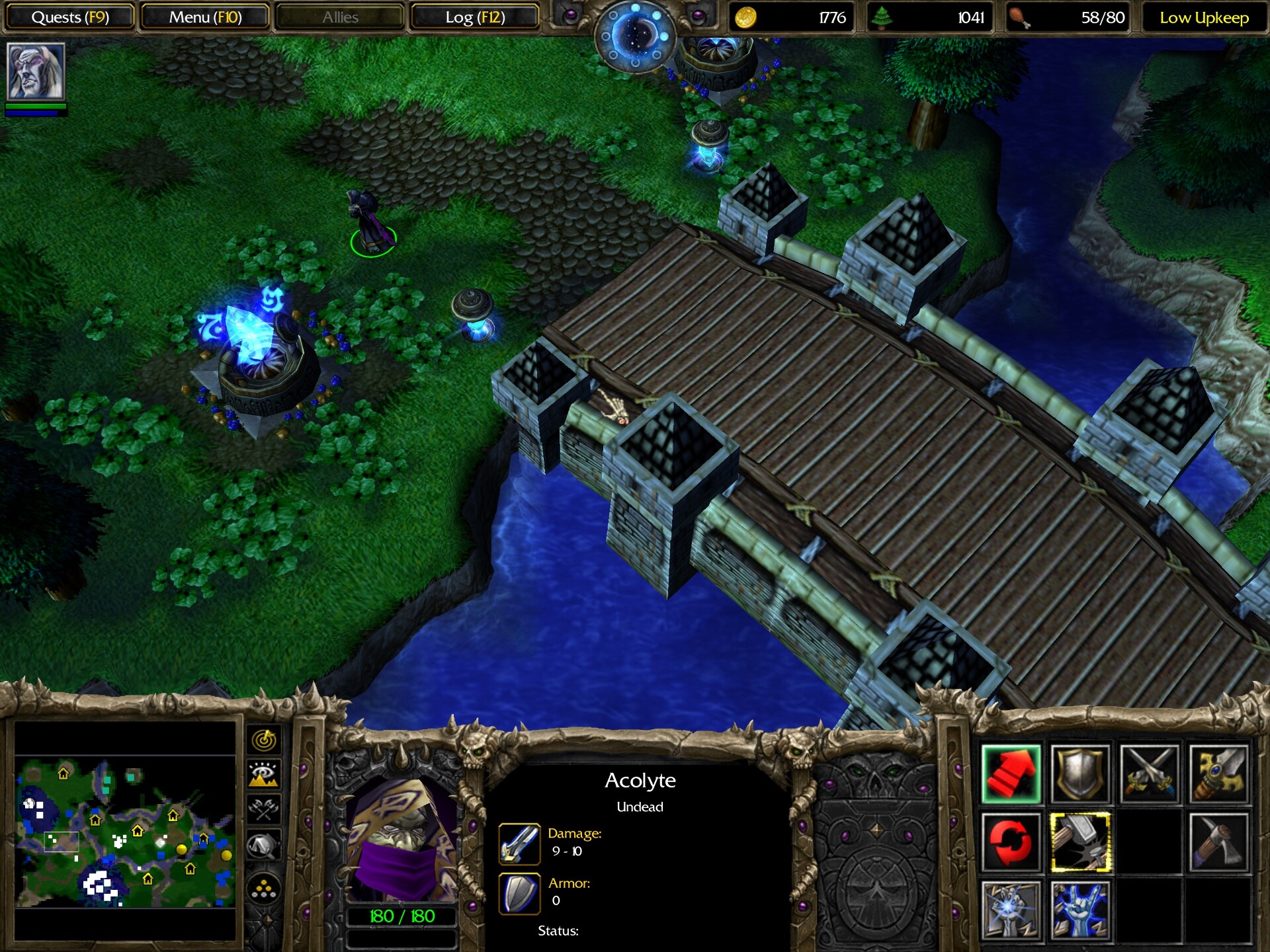
In my playthrough, I didn’t do it until I had already built up an army and ferried it across with zeppelins. The northwestern base is the main one, with a ton of defenders, zeppelins constantly unloading more, and Sylvanas herself. Necrowagons still work here, although they need some support from crypt fiends to bind dragonhawk riders and zeppelins. I also erected a ring of Spirit Towers around my base to repel dragonhawk attacks from the northern base.

This mission has a lot of replay value because of its complicated geography. You can use zeppelins, or you can just take the central island, which has portals to all three enemy bases and a gold mine to boot. You can repair the bridge. You can take the bases in different order…
One annoyance is the limited inventory slots. The urn already takes an inventory slot, and another one is used for the key as it’s being assembled. Since the mission ends when you bring Arthas (with the assembled key) to the gate, you can’t go back and fill the slot with something else before proceeding. And the loot continues to be lackluster. Ah well.
The gate opens, and Arthas has a case of That Makes Me Feel Angry as he charges through.
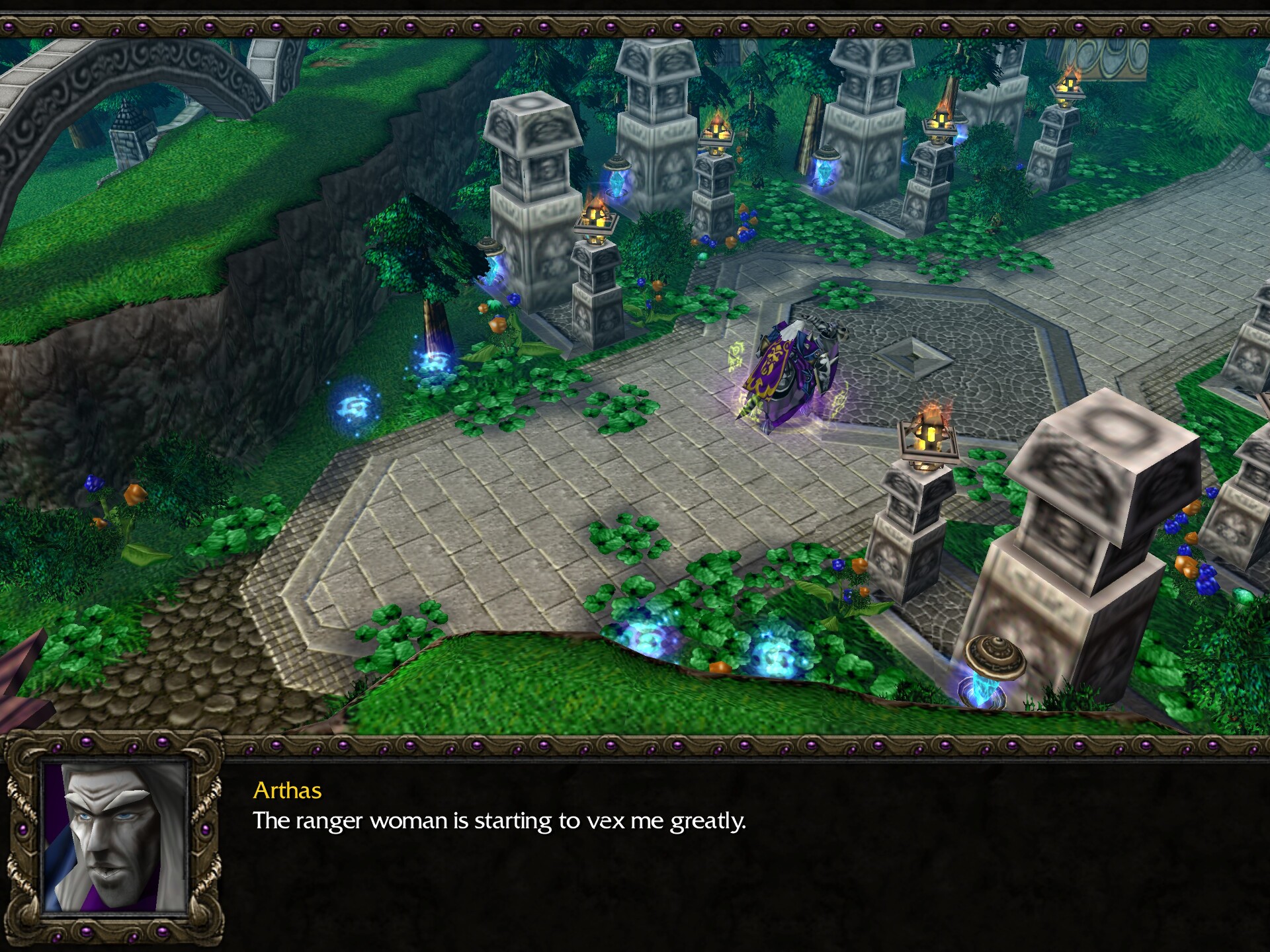
Next Up…
So far, the pacing has been fairly slow. These missions are largely concerned with setting up later developments. Arthas has reassembled the Cult of the Damned, dug up Kel’Thuzad’s decomposed remains, killed Uther simply because was in the way, desecrated his father’s ashes because they were in the way, and now he’s massacring elves on his way to raise Kel’Thuzad at the Sunwell, simply because they are in the way.
Everything, everything to him is just a speed bump on the way to whatever short-term objective he’s pursuing. It’s not that he specifically wants to spite his father’s memory, but it just happens that his urn has the magical properties the Scourge needs. It’s not that he specifically cares about Quel’Thalas, but he needs the Sunwell, and the elves won’t surrender it without a fight.
The first two Quel’Thalas missions are largely filler. They’re light on plot developments and mostly serve to establish Sylvanas as a persistent thorn in Arthas’s side. In the second half of the campaign, the dominoes are about to fall down and the pacing will really pick up.
Next up: the battle of Silvermoon!
Screenshots from Star Wars: Revenge of the Sith and The Order of the Stick: Utterly Dwarfed.
-
Assuming you acknowledge the prequels, of course. ↩
-
KOTOR 2, which had different writers, portrays the Light and Dark Sides in a more nuanced way, but these margins are too small to talk about that game. ↩
-
Remember this. For much, much later. ↩
-
Actually, when did Arthas turn undead? We weren’t shown that, either. ↩
-
Called the Dark Lord there for some reason. But in this campaign, everyone suddenly switches to calling him the Lich King instead. ↩
-
This is known as the “necrowagon” strategy. ↩
Comments
Rain King
Amidst a bit of a nostalgic reacquaintance with “Warcraft III”, I discovered this series a few days ago and have already reached this entry. As a former reader of Shamus Young’s work, it’s wonderful to see someone take inspiration from it — and kind of exciting to read as it progresses. A very cool work that’s inspired me pop in my old CDs again. :)
Leave a Comment